
Mastocarpus papillatus
Turkish Washcloth, Tar Spot Seaweed
Willow Point, Strait of Georgia, British Columbia, Canada
21 July 2020
Observations commenced 40 minutes before low tide, samples collected at 12:45pm PDT
Low Tide 2.0 feet at 12:25pm PDT (measured at Campbell River Tidal Station)
Weather: Clear skies, no precipitation, wind NNE 5 km/hour, smooth sea, temperature 22˚C, relative humidity 60%.
Phase of Moon: Waxing Crescent (24 hours into this phase at time of observation/collection); (Previous Phase, New Moon, 20 July 2020 at 10:32am PDT: Next Phase, First Quarter, 27 July 2020 at 5:32am PDT.)
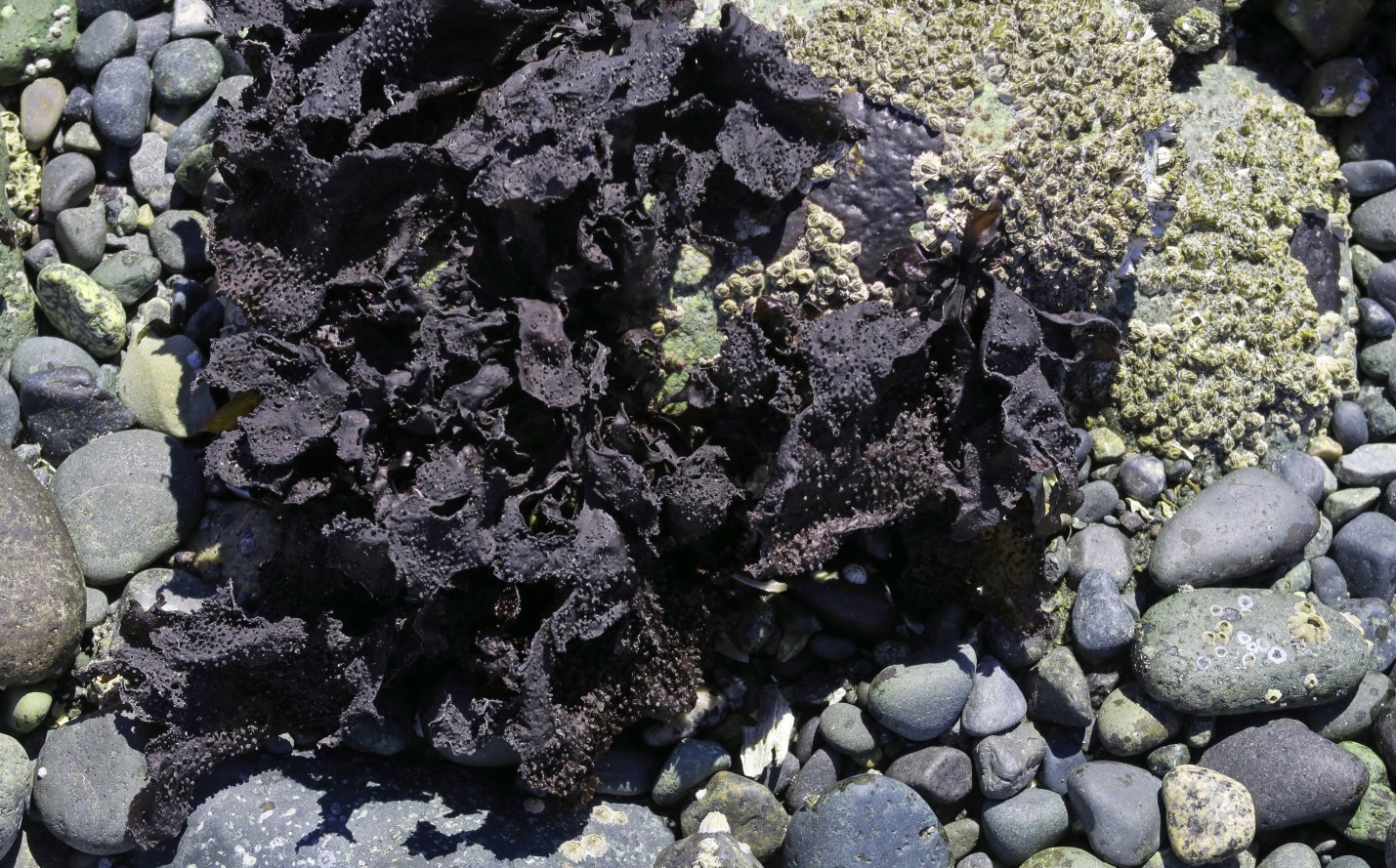
Figure 1: Mastocarpus papillatus – ‘Turkish Washcloth’ phase and ‘Tar Spot’ phase are both growing on this larger barnacle encrusted cobble. Willow Point, Strait of Georgia, B.C., Canada. July 21, 2020. Photo ID 27266 ©Seaweedwhisperings.com
In situ observations:
The live seaweed was observed in the high and mid-intertidal zones. The beach here is mainly cobbles (varying sizes) with sandstone ledge outcrops. Large glacial erratic boulders are sparsely scattered on the beach.
Person 1:
Black.
Ugly.
But not grim.
Dark is not bad.
Tar spot is smooth and shiny; shiny enough to reflect light.
Non-descript, but sees all from a perch on exposed rock.
I want to stand, not sit, for this interaction. I wanted to view it from above.
Wise.
Arises from rock with no distinct holdfast.
Lies exposed and crinkled.
Disorganized feel / appearance.
Pleasant rough feel to surface, especially where bumpy.
Bumps erratic and messily distributed on blade.
Dominates a rock.
Drab purple-y black when drying on rocks, but multi-hued olives and reds when in water.
Tar almost impossible to get off rock. Felt as though I was inflicting pain as I attempted this; it didn’t want to share that aspect of its being.
The small piece of tar that I did scrape off rapidly sank to the bottom of my collection bucket and sulked.
Tar was pleased to be observed in situ.
Highly visible but holding secrets.
Person 2:
I chose to work with you up very high in the intertidal – where it’s mainly you and the barnacles that can endure the long exposure to sun and the wind and air during long absences created by the tides.
You stand out.
Patches of dark blackish red / brown, textured with many ruffled leaves on the macro scale, textured with many small papillae in the micro.
It is hot here, mid-day in mid-summer on a very low tide – you’re tough!
You do know how to endure.
Where some blades / leaves still dip into pools of lingering salt water, your color lightens – to an olive green/brown, and your sun desiccated leaves soften and become somewhat more flexible.
Your thick black Tar Spot phase feels even tougher than your blades – like it could endure almost anything that the extremes of nature could throw at it.
I flipped over a dark dry leaf, and it is lighter colored and even moist on the underside.
You reserve water for yourself – very wise!
You are short. Have no need for height, it seems.
But you don’t hide out.
You’re out in plain sight – ruffled and notably distinct in color compared with your surroundings.
When the tide comes in it would never cover you with much water which is different than most other red algae. At best you’re in the shallows of the high intertidal zone.
And as the tide comes in it must send your ruffled blades into pleasing motion with the incoming waves. Lift you up, lay you down, lift you up, lay you down…., until finally, you are fully underwater. Then again you can feast – take in nutrients to continue your growth, in this small, shortest window of opportunity compared to other seaweeds.
Companion to the high intertidal rocks – Mastocarpus papillatus you have some special abilities.
You also can grow deeper in the intertidal zone where other seaweeds thrive – but there you have much competition. In the upper intertidal you are the best – the only other seaweeds are the odd bits of Fucus (bladder wrack) and Ulva (sea lettuce) and these are only sparsely distributed.
Where you have more water/less exposure, you do grow somewhat larger – life can be a bit easier it seems.
On the way from the beach to the vehicle I had collected a smaller rock with an entire Turkish Washcloth growing on it to continue my observations with. This rock had no obvious Tar Spot on it, so I looked also for a smallish rock that did have the Tar Spot phase on it. Tar Spots of notable size here were mainly on larger or immovable rocks – and as such they would be more likely to endure, remaining in place, undisturbed.
When I reached the parking lot I observed a spot of tar on the pavement near our vehicle – left behind from asphalt paving it looked so very similar to our Tar Spot seaweed, so a very apt name, indeed.
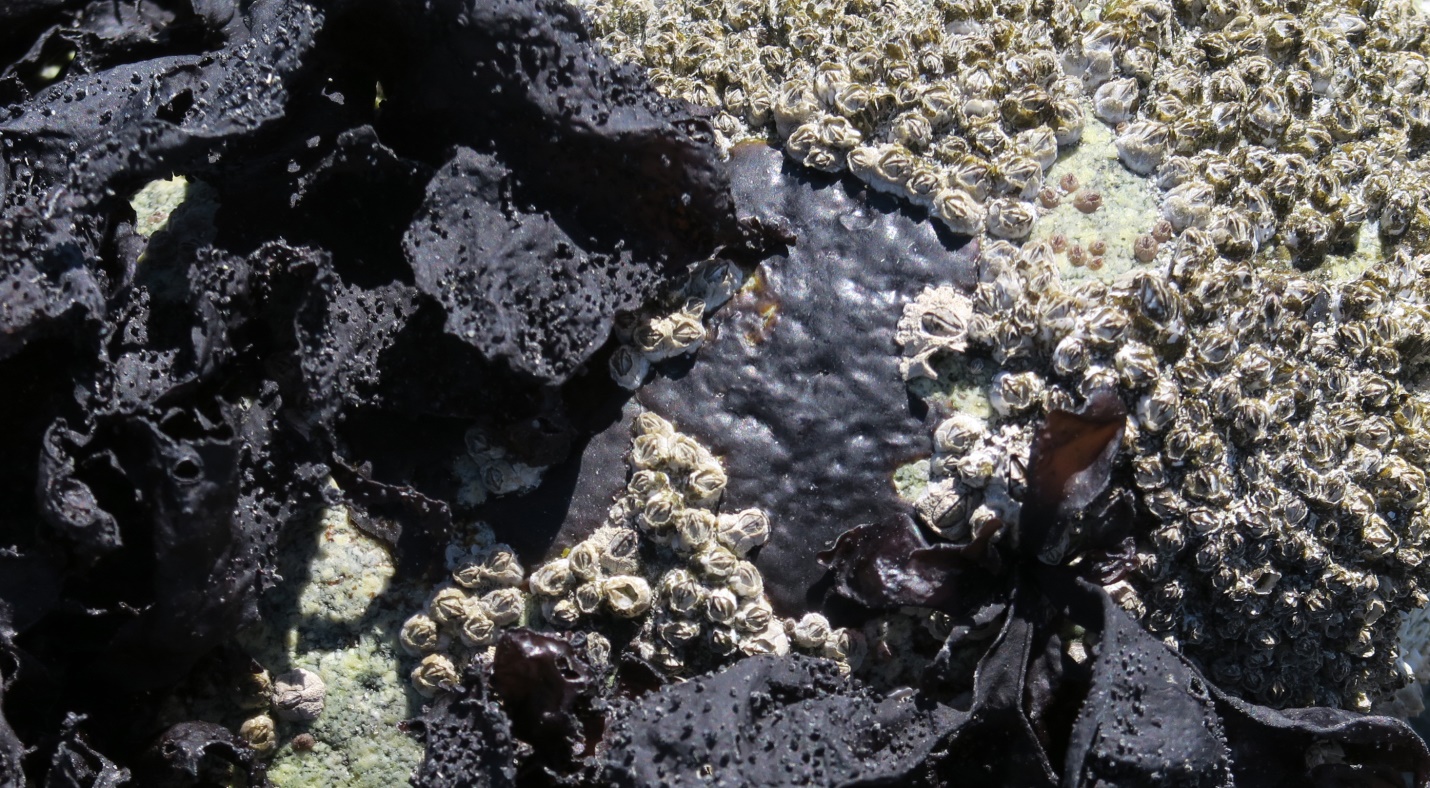
Figure 2: Closer view of the very dark red/black ‘Tar Spot’ that is encrusting the large cobble here adjacent to a spray of acorn barnacles. The foliose blades of Turkish Washcloth here have been exposed to high temperatures and a drying wind – they look black and brittle but endure and rehydrate amazingly well. Willow Point, Strait of Georgia, B.C., Canada. July 21, 2020. Photo ID 27267 ©Seaweedwhisperings.com
Further Observations & Impressions:
Person 1:
Lung-like lobes.
Pleasant, wandering lines.
Erratic edges.
My small piece of “Tar” (collected at the beach) has disappeared – dissolved like magic? Secrets destroyed…, or secreted yet again?
Don’t want to put this seaweed in my mouth to taste, only want to take in the visual energy.
“Mastocarpus” – masculine and strong.
“Papillatus” – apt description of bumps.
“Turkish” – surprisingly, no association.
“Washcloth” – can feel the pleasantly rough surface associated with the bumps.
“Tar Spot” – looks exactly like hardened tar used to seal cracks in asphalt.
Disheveled-looking, all-knowing, person of authority watching over their domain.
Wise and kind.
Magician – ability to change from secretive Tar Spot to conspicuous leafy-presence, then to disappear once again into secrecy.
All-knowing and secure in its paradigm (domain), oblivious to other paradigms.
Prefers to live in isolation but will peacefully coexist with others if necessary.
Isolation – Persons 1 and 2 interacted with this species in situ 40 meters apart from each other when there was plenty of opportunity to work side by side. Isolation, or at least considerable distance from others, is chosen.
Person 1 waited patiently for 30 plus minutes for Person 2 to finish her work.
Patience is natural for Mastocarpus.
It is fine to wait for the right time to make wise pronouncements or share insights.
There is no urgency to interrupt what is going on however ultimately this seaweed will share its viewpoint.
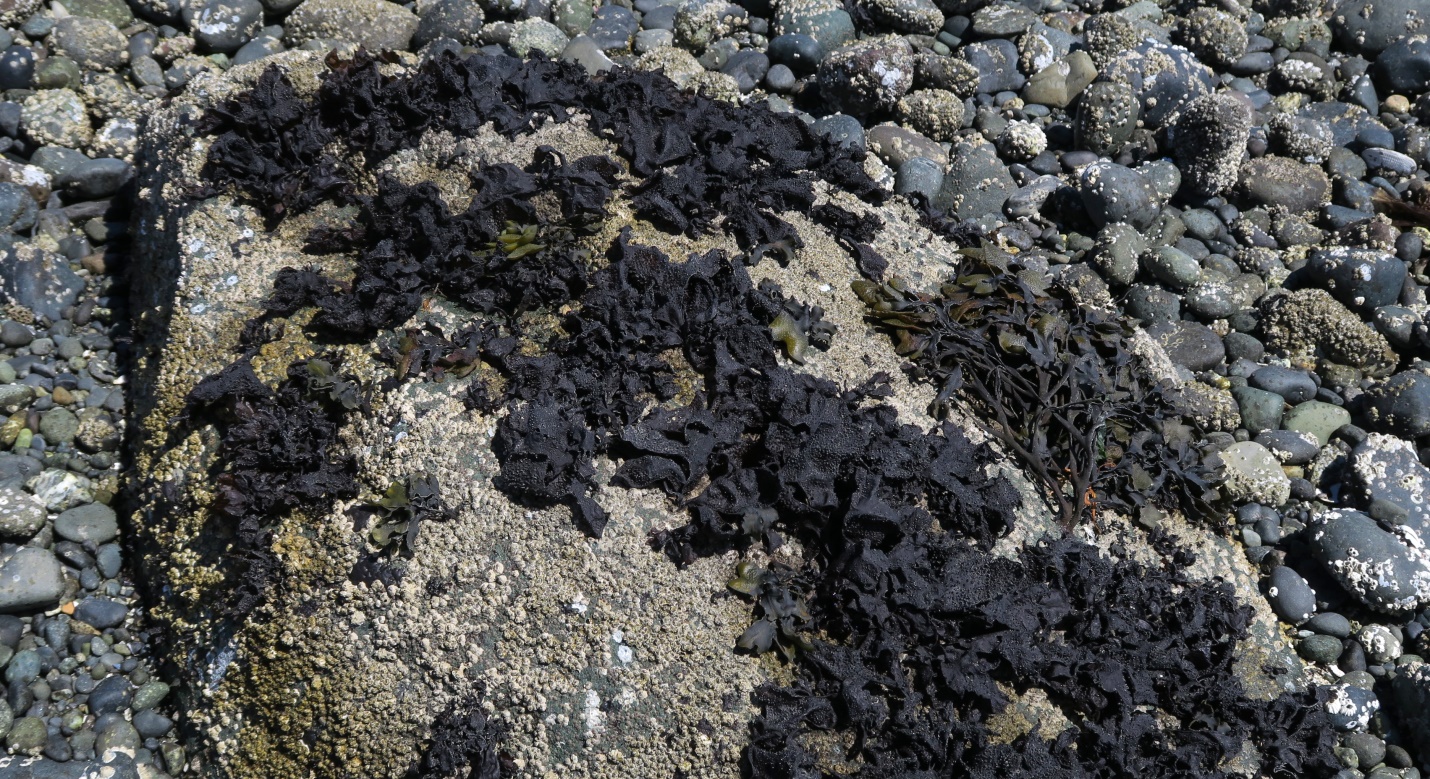
Figure 3: This large boulder hosts many Mastocarpus papillatus algae; a few tough patches of Fucus distichus subsp. evanescens put in an appearance also. This day was one in a series of low tides that occurred at mid-day when desiccation from high temperatures, sunlight and drying breezes had a substantial impact. The ‘blackened’ look here could cause one to doubt that this seaweed is alive, but indeed, it is, and this example contrasts starkly with the photo below. Willow Point, Strait of Georgia, B.C., Canada. July 21, 2020. Photo ID 27268 ©Seaweedwhisperings.com
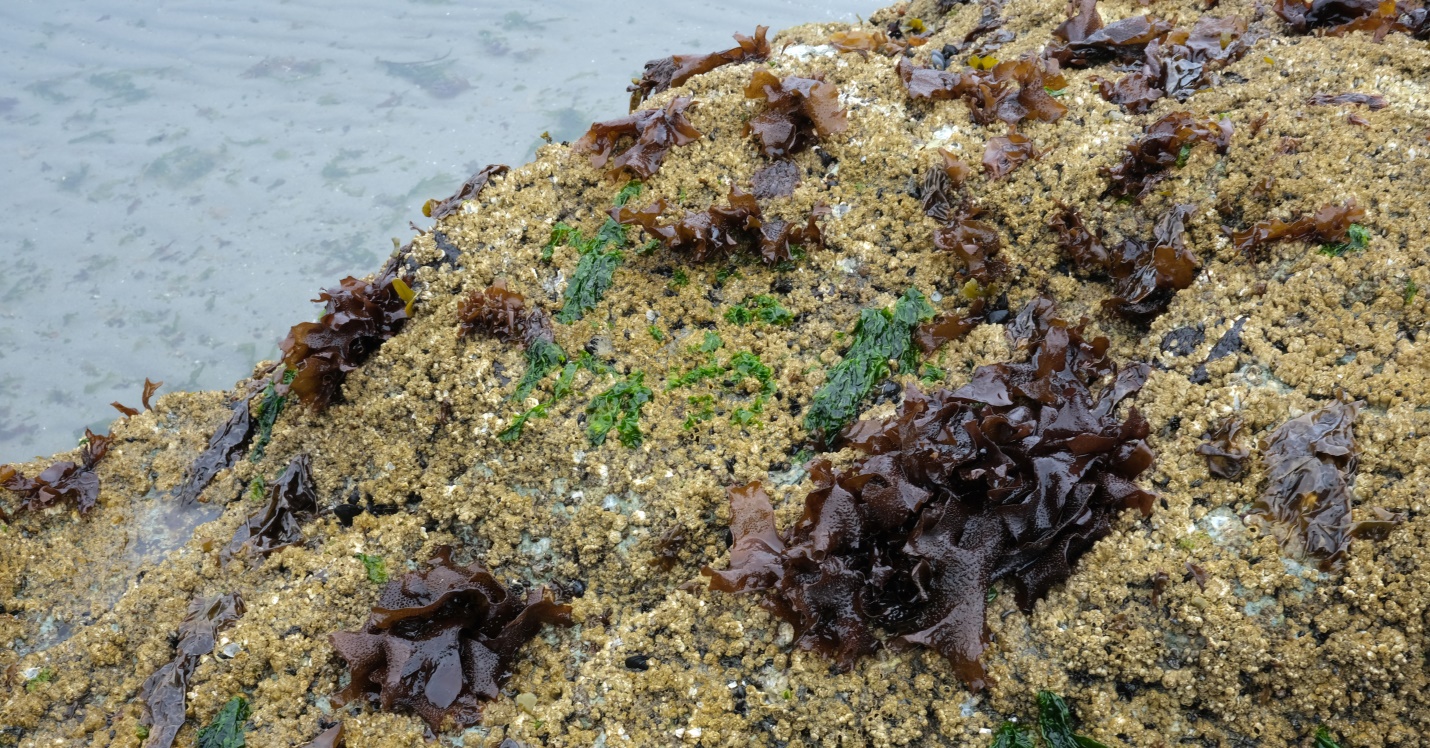
Figure 4: A different large boulder in a not too distant location (from the location of Figure 3), photographed on another summer day, is once again inhabited by Mastocarpus papillatus (and a few Pyropia and Ulva algae individuals). Two years and one heat dome later, the barnacles are yellowed and dead, but the foliose form of Turkish Washcloth is vibrant and alive. Stories Beach, Strait of Georgia, B.C., Canada. June 16, 2022. Photo ID 27269 ©Seaweedwhisperings.com
Person 2:
In my basin – immersed fully in sea water now for 2 hours, the seaweed is very dark red/brown/black in color. When not blackened with desiccation, the seaweed has rich undertones of color.
The leaves float out from their holdfast, radiating in all directions, forming a circle of ruffled foliage.
The terminal ends of the leaf blades seem to mostly to form two points like ears or horns atop the head of some animal.
Leaf blades are translucent olive/red/brown when wet and dotted darkly with 1mm sized blobs – these are the papillae.
The papillae are very visible. They are also very evident by touch.
The papillae are quite irregular in shape; blobs of tissue protrude distinctly from the flat blade that are scattered in an irregular pattern over the surface but not on the edges (margins).
The papillae protrude equally on both sides of the blade and there is a pleasant raspy feel when I rub my fingers against the wet blade.
The papillae are tough, and also somewhat flexible.
The growth of your blades, Mastocarpus, is much more in width than height. There is also considerable ‘growth’ in the surface area of the numerous papillae.
You seem quite pleased to be the focus of my attention.
You pick the top of the rock for your home – but in some cases your rock is not all that large. It seems that you try to have your ‘top’ at least a bit higher than your surroundings.
What does that ‘top’ place give you?
More light?
A view?
Your holdfast is so small that I can’t see it / find it.
Is it tucked between the barnacles you grow adjacent to?
Is that how you get established at “the top” – the barnacles shelter you from being washed away when you are young?
At a quick glance, one could say you look tattered.
Certainly there’s a quality of raggedness to your perimeter edges and your overall visage.
But you are not torn, I don’t see tears or tatters and only a few grazers have chewed one or two holes in your blades.
When I tried to create some wave action in my basin, I found that the water moves through the V’s and forks of your blades and so you are not disturbed much by water action at all. Maybe the very, very narrow base of your blade helps you stay in place like this.
Very narrow to very broad in very little distance. This is how you grow.
You “fan out” rather than “reach high”.
Smell is mildly of iodine.
I tore off a small portion of one blade, it tears quite easily.
Chewing this piece, all I am aware of is the texture of the papillae, they stand out. They’re crunchy, almost unpleasantly so. After several chews all that is in my mouth are these persisting small lumps – not a rewarding experience.
There is no taste other than of the sea.
You are quite surprised that I tasted you – as if you are accustomed to being overlooked by grazers who have a preference for tastier options.
Attention now to the Tar Spot on my ‘sample’ rock.
In situ you looked very black. Now that you’ve been immersed in salt water again for some time, your color returns – you look the same very dark red/black/brown of the “Washcloth” phase.
With a hand lens I was surprised to see that the Tar Spot is not a smooth surface – because it looks so very smooth from a distance, it had an almost a “melted on” appearance. Instead the surface of the Tar Spot is dotted with slightly raised tiny bumps. It also has some ‘give’ now that it is hydrated again.
Again, texture is a prominent feature in this seaweed.
The Tar Spot looks like it will encroach and even cover over other life on its rock, such as very small barnacles. Or does it secrete a toxin/poison of some sort at its edges so it can advance its own growth and repel others?
Nothing at all seems to grow atop the Tar Spot; it stays clear of any epiphytes or hangers on. This is notable to me when in so many ways the intertidal zone is crowded with different life forms, each needing some space.
Why does nothing encroach on the Tar Spot?
“Mastocarpus” – I get the hint of the word “master” here. A master of what…?
“Papillatus” – to say this name, it even sounds like it is punctuated with many parts/bits/components. Multifaceted? Only knowable in parts?
“Turkish Washcloth” – the projecting papillae resemble in looks the projections of a terry towel washcloth but not in texture – they are in no way soft. I wonder if they absorb/hold water like a towel is designed to.
You’re like a clown or a court jester, Mastocarpus papillatus.
In that role you show a ‘truth’ but in a “peppered” or indirect manner; truth is interspersed with other things.
One could choose to hear your message, or instead, see only your surface costume/disguise and dismiss you as a fool or a clown.
You sit up high.
You must observe/witness a lot, but you don’t have an audience – or only occasionally do. Do you mind this?
I think you have a faint memory of what it was like to be given attention to, but now you’ve resigned yourself to your small or short-lived audiences.
Your view point / opinion is still of interest to you, but it is largely unheard.
In a way you’ve toughened up to this reality. If no one wants to hear your wisdom, well, it still serves you. That’s something, at least.
You’ve found your niche and it is not for the weak and especially not for those who cannot abide isolation.
Moments rich with interaction are not long-lived, and there is much, much time with little interaction. The majority of your life lies “in between” – much time while you hang on, live through, and quietly endure.
There is not a right side, or an upside, or a best side to your leaves / blades.
All surfaces are equally important it seems.
This imparts a way of seeing, and being seen, that has multiple perspectives and interpretations.
It seems that you won’t stand in judgment, however much you see or witness, and you may wish the same neutrality was granted to you.
As “Tar Spot” you certainly don’t even look like a plant.
As “Washcloth” you look a rather fanciful – a plant that is a caricature for………?
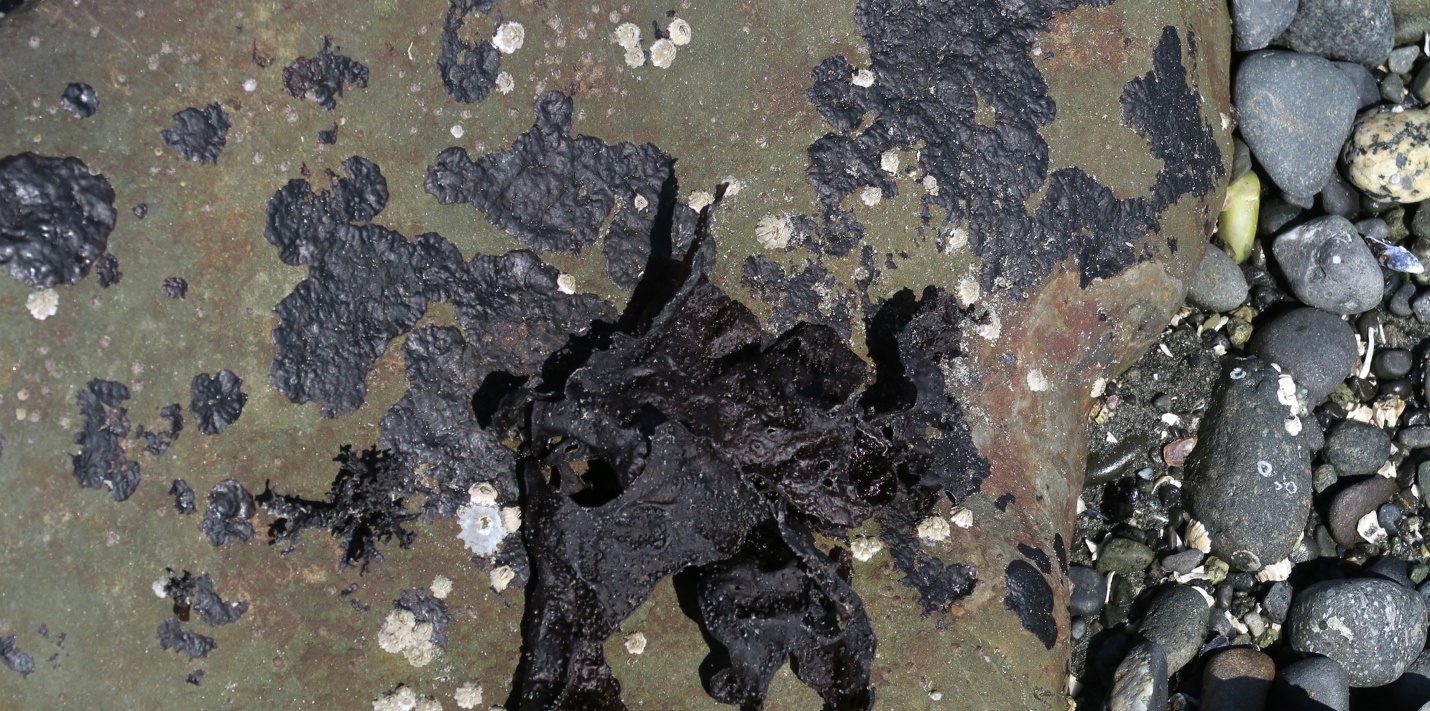
Figure 5: A few Mastocarpus papillatus blades and several spots of the alternate ‘Tar Spot’ phase are the only algal life on this high tide boulder. Willow Point, Strait of Georgia, B.C., Canada. July 21, 2020. Photo ID 27270 ©Seaweedwhisperings.com
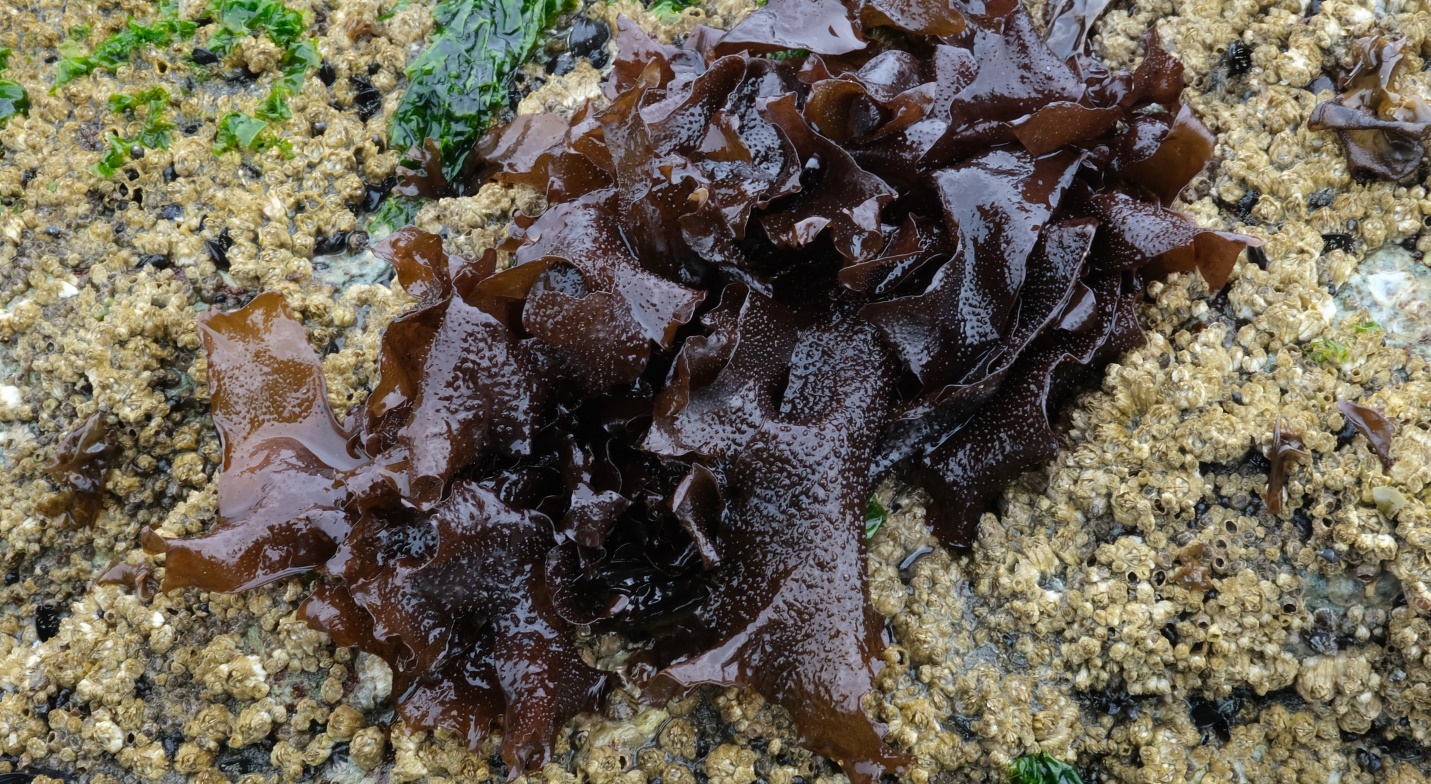
Figure 6: A closer view of this female Mastocarpus papillatus algae – the papillae that cover the blades denote the sex. Relatively untouched by desiccation, the red brown color and glossy shine of this individual possesses a vibrancy you would not expect in comparison to the photo immediately above. Stories Beach, Strait of Georgia, B.C., Canada. June 16, 2022. Photo ID 27271 ©Seaweedwhisperings.com
Discussion:
Are you the “best” in your ‘area’ because you are virtually the only one there?
Or are you the only one there because of some other reason?
Is solitude of value to you?
Rich undertones contrast with black and ugly. There is a great difference here. Just about as different as the tar spot is from the washcloth.
In the water, there is shining color, more flexibility, interaction and sustenance. Out of water, there is rigidity, flat matt blackness, solitude and fasting…, abstinence from life!
You are accustomed to being overlooked. Why? What happened? Or does that suit you, being overlooked, does that give you something?
Quietly and with long patience and a touch of clever wit, you observe and remember and review. You can be a ‘master’ of presenting truths, but you do so as if in a riddle, pieces of truth dotted here and there. One must “connect the dots” to grasp what you are hinting at.
You can see both sides, but you also have two sides to yourself.
How did this separation, into two sides, come about?
You are much concerned with being viewed as “not bad” – so you have a hidden side, and you have an official / publicly viewed side. The two are strikingly different.
Your two sides / two lives are mutually self-isolating. The one does not intersect with the other, and you strive to keep it this way.
This seaweed has two distinct and alternating phases, a tar-like form that appears as a crust on rocks, and a foliose form that resembles a more typical ‘leafy’ seaweed. Due to these differences, taxonomists originally described these forms as separate species – that is just how disparate they are. In this Whispering, we interacted with both phases, and thus the reader is reminded to hold both images in mind.
Duality arises as a theme. Physically, the two distinct phases described above are a clear example. More so, the outward observable expressions are a stark contrast with secretly-held inner expressions. There is an almost desperate desire to be judged as being “great / good / fine” and equally an aversion to be judged on anything “not great”. As a result, anything believed unacceptable to the majority is kept well hidden. Mastocarpus wants to be seen publically as what is commonly accepted as ‘good and appropriate’, however in private, there is actually quite a loosening or freedom from these same standards / judgments.
An example of behavior that could illustrate the darker side of this seaweed’s energy is a pledged celibate priest who is seen as a role model and spiritual guide to the majority of his congregation, but has a second life as a pedophile that almost no one knows about. Or, it might be royalty putting on airs of decorum and properness, while having a much enjoyed loose and wild secret lifestyle as well. Yet another example of this ‘dual’ life is that of an under-cover agent or spy. The agent works hard to maintain his ‘cover’ and who he really “is” must be hidden, protected from discovery, often as a matter of life and death. In less dramatic examples, such dualities need not touch into areas of danger or immoral behavior, but the urge to maintain the separation is just as strong.
What is it like to live like this? Mastocarpus suggests that it is quite painful. There’s an inner tension of simultaneously holding secrets and maintaining an outer image – this is restrictive. Each of the two lives threatens the veracity of the other – this is isolating. Maintaining the duality is paramount – because the image of the more socially correct life is of great value. There is fear that reputation and life possibilities will be undermined if this other aspect of the dual nature is revealed. So the individual is restricted, confined, trapped in the need to maintain half-truths, deception, and unfailing secrecy – all of one’s own making.
Is it in solitude then, the kind that has one meet one’s own self as there are no ‘others’ to distract, is it in solitude that Mastocarpus papillatus has the opportunity to reconcile and integrate “both sides” of its nature? Possibly this is the only way the extremes can be viewed side by side and in the light of day.
Another more colorful side of this seaweed’s energy is that it can be a very perceptive observer, particularly where double standards exist. It’s like the court jester who reveals, in comedy or satire, the foibles of royalty or the conflicting realities of certain circumstances and times. The seaweed / jester is not living the duality itself. It simply serves to bring attention to the issue – can ably identify the duality for what it is. Now there is an opening created; one can consciously choose which “side” of these two lives / two circumstances is most suitable, authentic or fitting, and even possibly one could embrace both “sides” in a more informed coexistence.
Late in the ‘discussion’ phase of this interaction a ‘connection’ with Turkey and the common name Turkish Washcloth suddenly arose. As a transcontinental nation, Turkey has for centuries been a cross roads and major trade center. Merchants and traders would travel from afar to do their trading, and also, to gather information (what is now called ‘intelligence’) on the status of other nations and competing interests. Since ancient times, merchants had the double life of also being spies. How interesting it is that the fame of Turkish towels is what has given rise to the name of the seaweed, Turkish Washcloth – a seaweed that embodies this particular energy of dual lives.
Also, the very narrow base of blade of this seaweed widens out quickly and broadly. This is like the region of Turkey near Istanbul, between Europe and Asia. The land widens out broadly above the Black Sea and the Mediterranean Sea to the nations of Greece, Bulgaria, Romania and Ukraine, and also widens out below to the Middle Eastern countries. These chunks of land, to one who has observed the Turkish Washcloth macro alga closely, bear a striking resemblance.
We returned our living specimens to a different but very similar seashore locale. At first, while looking in the mid-intertidal area, we couldn’t locate any Turkish Washcloth individuals. As soon as we shifted our attention higher up the shore, we found our seaweeds, growing prominently atop their rocks, isolated from most of the rest of the other seaweeds and high above the current water line.
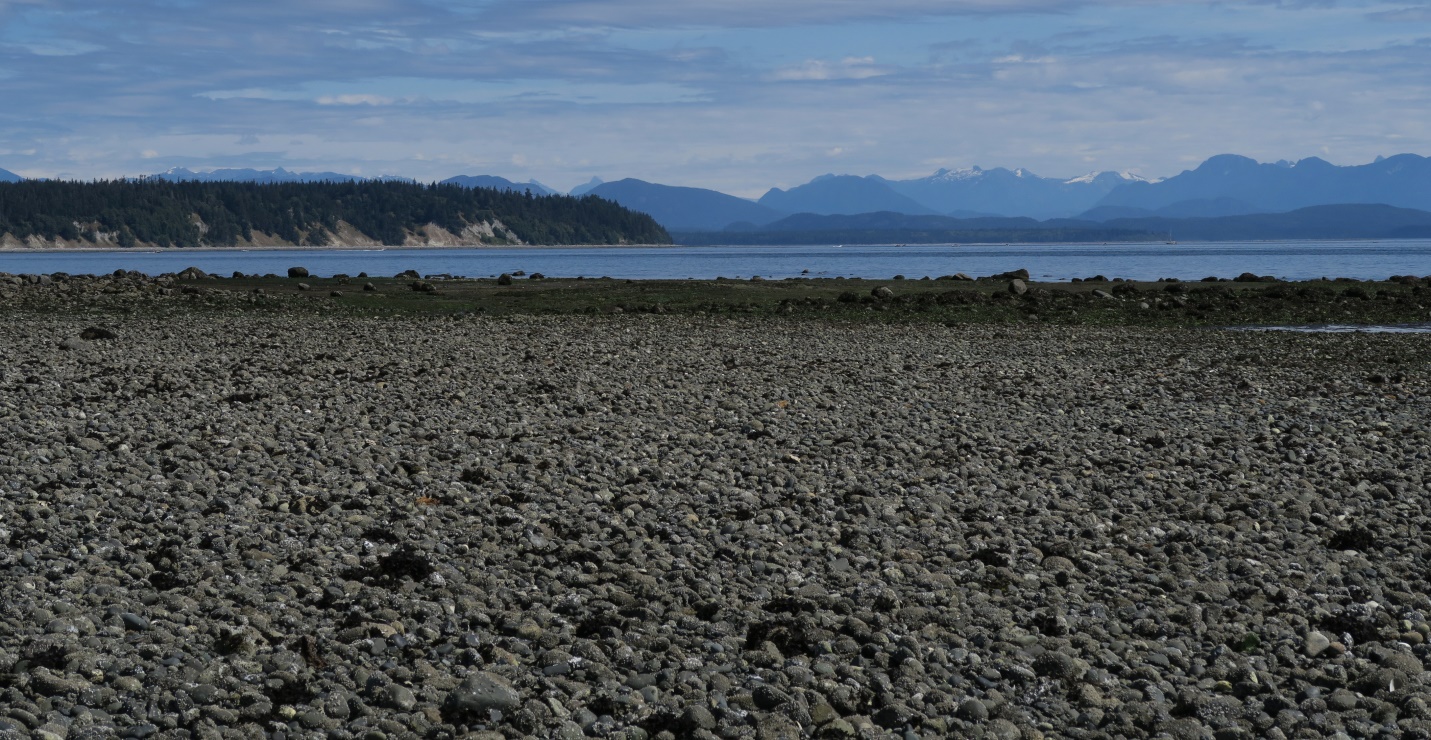
Figure 7: The very dark patches that are scattered amongst the extensive area of grey cobbles in the foreground are not rocks – these patches are the sun & wind blackened foliose form of Mastocarpus papillatus! Way off in the distance and closer to the water you can see the greenish band where most other seaweeds find the conditions suitable for their existence. Willow Point, Strait of Georgia, B.C., Canada. July 21, 2020. Photo ID 27272 ©Seaweedwhisperings.com
Biology & Natural History Information:
Description:
Turkish Washcloth varies from dark red-brown (sometimes almost black) to yellowish brown in color. This red alga alternates between foliose and crustose forms. The leafy foliose form has irregularly or dichotomously branched tough blades that grow on average to 15cm or more in length. The female blades are covered with small bumps called papillae. The gametophytic blades are annual, dying back to the crustose base at the end of each season, but the crust itself is perennial, capable of re-growing new blades annually. When males mature, spermatia are produced over both surfaces of the blades. The spermatia float to female blades and fertilize cells near the tips of papillae which are located all over both surfaces of the blade. These papillae are very noticeable and give the blade a shaggy or carpeted or towel-like appearance.
The tetrasporophyte (spore producing) phase has the common name of Tar Spot and forms a thick, blackish layer that varies from a few cm to 30 cm across. It is opaque and usually a very dark red color that often appears nearly black. Tar spot is smooth and has a rather irregular, circular outline. This phase is slow growing with studies in Washington State finding it grows only 1.3cm per year. It is also extremely long-lived. Estimates indicate larger specimens to be 90 years old – a stately age for algae.
Habitat:
This seaweed is very abundant on rocks through our region (the Pacific Northwest) in the mid to high intertidal regions. Visiting the shoreline at high tide this is often one of the few species not yet or just barely submerged. Anchored to boulders and cobles one can find Turkish Washcloth growing robustly – often in both of its heteromorphic alternations of generations.
World Distribution:
Bering Sea and Aleutian Islands, Alaska to Punta Baja, Baja California, Mexico; it is also found on the coastlines of Japan and Russia.
Remarks:
The upright thalli (blades) are the gametophytes and these alternate with a thick, tarry looking tetrasporophyte crust. Before these two stages were recognized as part of the life cycle a single species, the crust phase was described as a distinct species in the genus Petrocelis.
Turkish Washcloth can undergo considerable desiccation and it can withstand high temperatures. Studies have shown that when the blades of this species are wet, they evaporate water from their surfaces, which keeps them below ambient air temperatures. Dried individuals cannot evaporate water and can exceed the temperature of the surrounding air (especially when there is little or no wind). Thicker individuals dry out less easily, and individuals that are more branched dry out more readily. In Turkish Washcloth, it is concluded that the temperature and rate of drying of individuals are controlled by anatomical characteristics.
When Turkish washcloth is subjected to heating and desiccation at low tide studies have shown that photosynthesis is inhibited. After a two hour exposure at 25˚C, the gametophyte blades can recover their photosynthetic rates within ten minutes of being re-immersed in seawater. At 30˚C recovery is complete but delayed by two hours, and at 35˚C the thermal tolerance was exceeded – no recovery was recorded. Rate of photosynthesis is also decreased with increasing desiccation; with less than 25% water content in the blades, there is no net photosynthesis.
The tetrasporophytes of Turkish washcloth (the Tar Spot) collected from southern British Columbia/northern Washington State were able to withstand submersion for a week in a water temperature of 28˚C, making this among the most thermally tolerant of all of our species of algae. The gametophytes were able to withstand an impressive 25˚C.
Limpets are among the intertidal grazers that eat this species. The gametophyte has a moderate caloric value (3.38 calories per gram of dry weight), but the caloric value of the crust/tetrasporophyte is unknown.
Classification:
Phylum: Rhodophyta
Class: Florideophyceae
Order: Gigartinales
Family: Phyllophoraceae
Genus: Mastocarpus
Species: Mastocarpus papillatus (C.Agardh) Kützing 1843
Previous name(s): Gigartina papillata
![]()